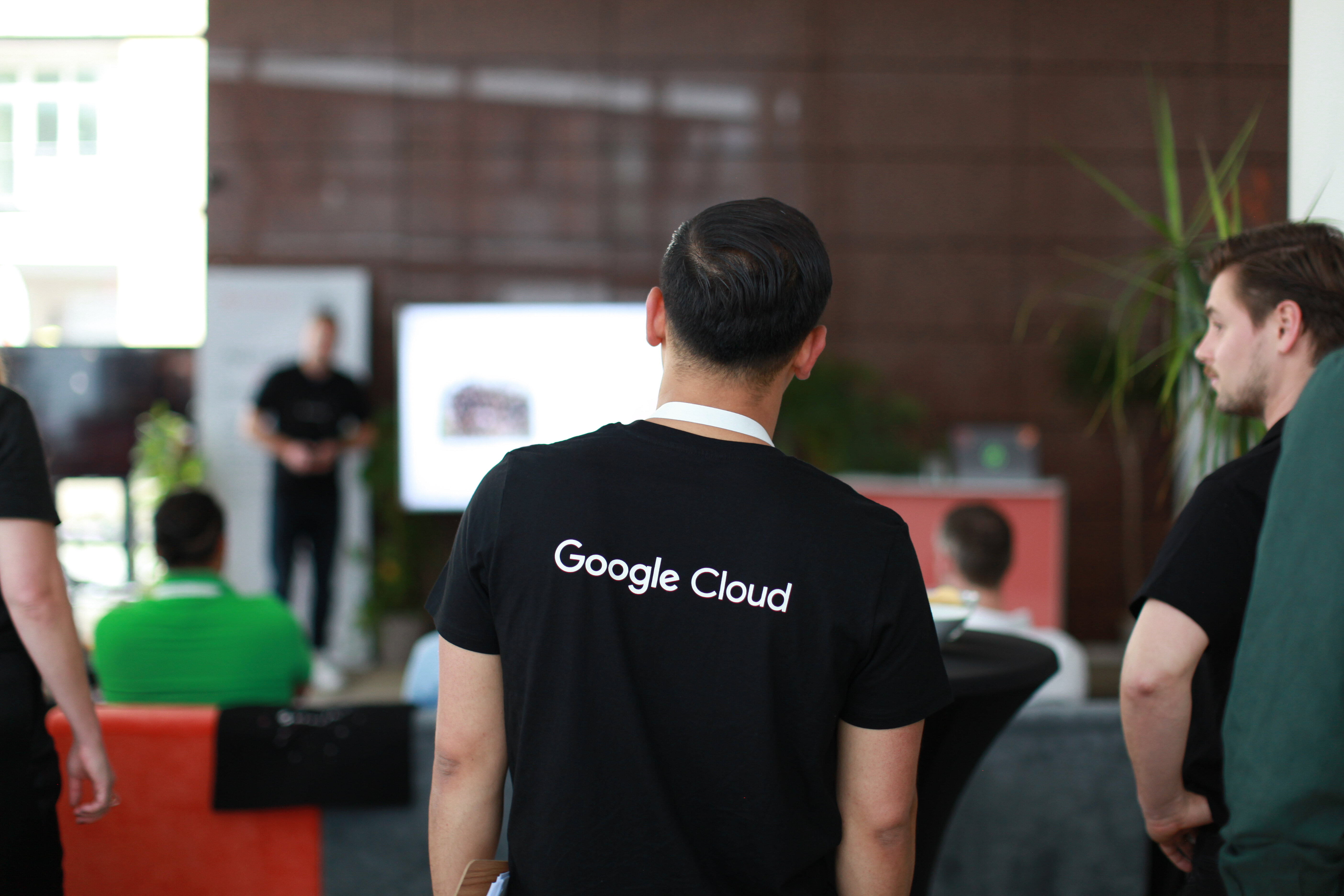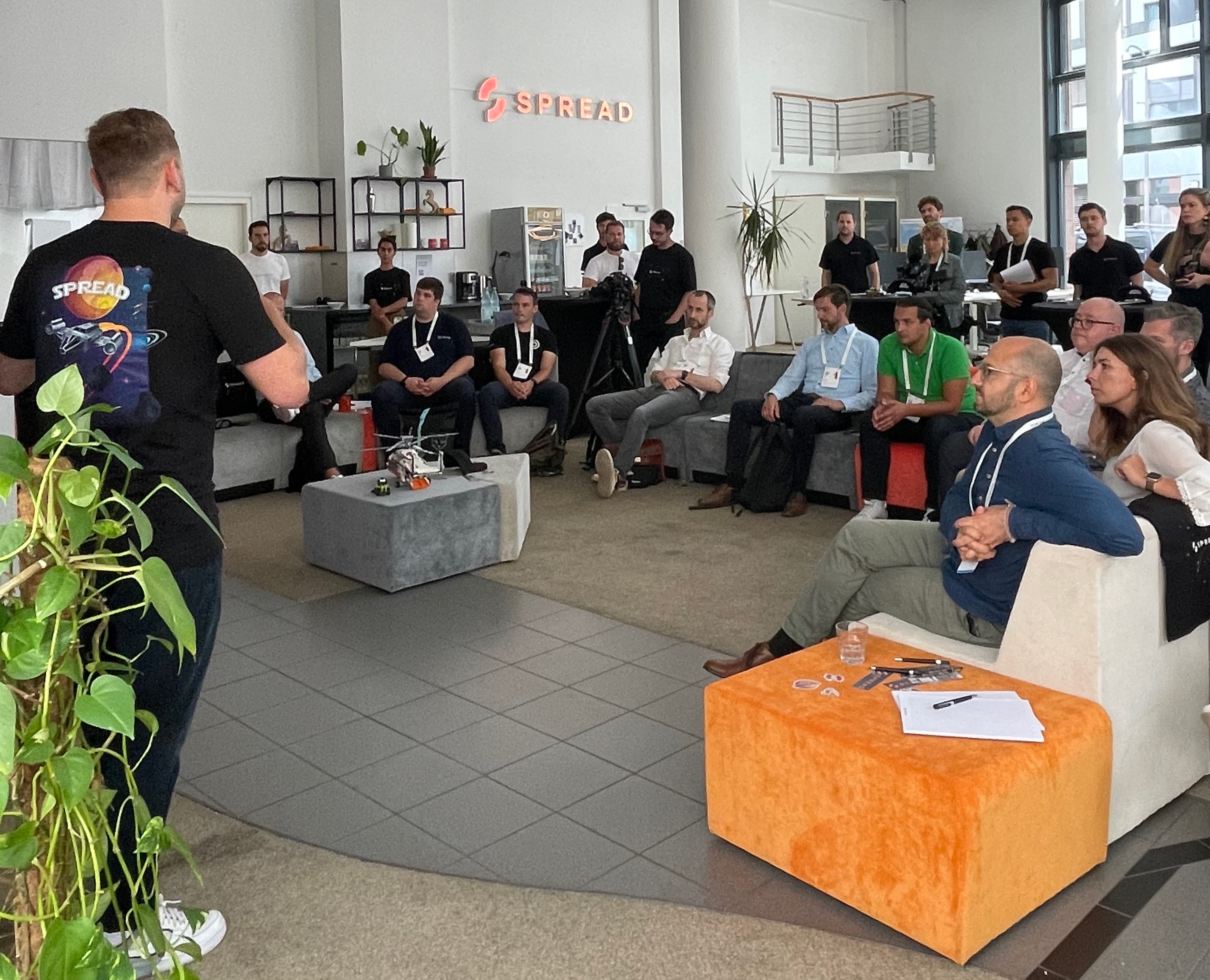How SPREAD Enables Automotive R&D Leaders to Eliminate SOP Delays Maturity Control
Boost R&D efficiency and cut time-to-market by up to 2 years with SPREAD Action Tower—unify your data, reduce rework, and drive innovation. Read more now!
This summer, we had the pleasure of hosting a delegation of CXOs from the Google Cloud Learning Expedition. 40 top executives from various industries visited SPREAD as part of the opening of the new Google Campus in Berlin.

SPREAD’s Co-Founder & MD Robert Göbel welcomed our guests and introduced our mission — to make product information easily accessible & actionable for everybody.
We work with engineers in Automotive, Transportation, Machinery, and Aerospace & Defense. Even though they work on different products, they all share a common challenge: navigating a high degree of complexity to get those products to work.
It’s a complex mechatronic system made up of:
- around 30,000 parts
- roughly 6 kilometers of wiring
- over 100 million lines of code
But a car is more than the sum of its parts. Getting a car to work requires a lot more than putting all these elements together.
There are 10,000 engineers working together to bring a product line to the market and maintain it throughout its lifecycle. Each of them is working on one piece of the puzzle.
The challenge lies in making sure all the pieces fit together in the context of the overall system. Engineers spend an enormous amount of their time getting this context because there is no complete picture of the puzzle. No one has it.
That’s exactly what we’re working with. Considering how complex such a puzzle is, it’s a remarkable feat of engineering that these engineers can get a car to work.
It is not feasible for any engineer to grasp all of the contextual information — the requirements, components, properties, dependencies, and engineering logic, to name a few — they need to get a comprehensive understanding of the product.
What are those consequences?
1) Immature market releases: an American study revealed that between 2011 and 2020, every car sold was recalled twice.
2) Resources for context-building: engineers spend 70% of their time synchronizing information and getting contextual knowledge.
3) Slow and expensive R&D: with development cycles of up to 6 years, bringing one car model to the market can cost between €2–4 billion in development.
In the last 50 years, product innovation was primarily based on mechanical advancements. Software and electrical/electronic components didn’t play as much of a critical role as they do today and could be treated as separate domains, vs. as a central part of an integrated system. Product complexity was increasing at a steady pace and could be managed by adding more engineering resources.
This means that the complexity can no longer be managed with linear solutions like increasing the engineering power. Our perspective needs to shift from isolated domains to an integrated mechatronic system.
And our engineering tools need to reflect the reality of integrated systems.
Engineers need to understand the relationship between mechanics, software, electronics, functions, and requirements. They get this contextual understanding manually, by gathering information from separate sources (their various tools, systems, databases, files, and often their colleagues). It’s the only way to grasp how everything works together.
But this approach is not scalable or sustainable.
An omniscient-like tool that can do it all, to replace all previous tools and break knowledge silos.
This would give engineers all the support they need. They could focus on innovation without losing time searching for product information.
Implementing such a tool and ditching the current way of working would require expensive, many years-long change projects.
This is also not scalable or sustainable.
Our approach is connecting existing tools and systems instead of replacing them. SPREAD’s technology is an information layer that creates an intelligent graph out of the tools in use at an engineering organization.
This way, engineers can access all the information they need to build a contextual understanding, while organizations can seamlessly adopt a new technology and quickly achieve time to value. They can access more accurate suggestions for better decision-making and faster problem-solving.
Every piece of the puzzle is different, and there are many engineering challenges that require a tailored approach.
To illustrate the different use cases for this technology, Robert introduced two of our colleagues, Louis and Freddie, who showcased two different ways that engineers are using SPREAD’s Engineering Intelligence Graph:
Let’s imagine a car nearing the end of the production line. Although it looks finished, there could be some software or electric errors.
We need a testing device to determine what symptoms the car has. This device provides a list of the vehicle’s malfunctioning control units (ECUs). Alongside this, we get the corresponding diagnostic trouble codes (DTCs) for each symptom.
By using this information, we can diagnose and address the potential errors in a car’s problems.
But how can we efficiently navigate the complex architecture of modern automobiles?
Louis explained how we can visualize the vehicle model through a 3D representation. In the demo, he showed how this helps us identify the location of errors and narrows the scope of solutions.
Watch the demo below:
Now imagine this: your washing machine breaks down. Would you try to get it fixed, or would you just buy a new one?
Purchasing a new machine is often the easiest and fastest solution. Yet, this approach generates excessive waste and unnecessary expenses.
Unfortunately, there’s a knowledge barrier that stops most people from opting for the sustainable choice. The repair manuals are often too technical. It’s unclear what is causing the error. You don’t know what needs to be replaced, or even if it can be fixed at all. You need to consult a specialist and that takes more time and money.
For large industrial machines, it’s not much different. Repairing a machine is complex, and downtime can be very expensive.
Our Head of Product, Freddie, unveiled how our customers can be more sustainable and efficient with our solution. Identifying spare parts allows machine suppliers and operators to collaborate with each other.
Watch the video below:

The ultimate goal of us at SPREAD is to connect people — customers, manufacturers, suppliers, you name it.
We are extremely grateful to the Google Cloud delegation for thinking of us and having us as part of the Learning Expedition!
Their visit proved once again the importance of bringing people together. Fascinating ideas emerge when connecting people from across functions, organizations, and industries. Sharing experiences and learning about other perspectives creates common values.
CUBE is the first engineering intelligence conference that brings together a community of tech and engineering leaders across industries for a full day of interactive discussions, expert panels, talks, and of course, good food and good fun.
The second edition of CUBE will take place on November 9th, 2023 in Berlin.
Want to see what’s happening at CUBE?
Check out https://www.spread.ai/cube for more information.

How SPREAD Enables Automotive R&D Leaders to Eliminate SOP Delays Maturity Control
Boost R&D efficiency and cut time-to-market by up to 2 years with SPREAD Action Tower—unify your data, reduce rework, and drive innovation. Read more now!
Read More
Closed-Loop Manufacturing: Can Digital Twins enhance innovation and efficiency in Production?
Revolutionize manufacturing with closed-loop processes. Discover how digital twins, real-time feedback & data-driven insights cut costs & drive innovation.
Read More
Read faster, decide faster: why sentence case delivers clarity in complex engineering software
Discover why SPREAD AI standardizes on sentence case across its platform. Design Lead Ricardo Trindade explains how this simple UX choice reduces cognitive load, improves global readability, and builds a calm, trustworthy product experience for engineers.
Read More